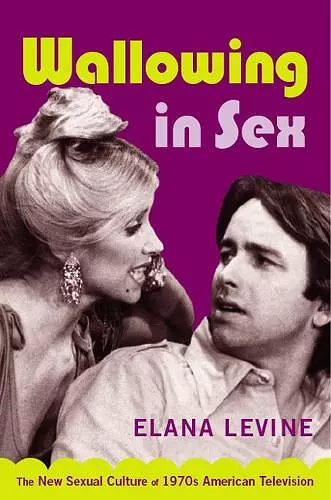Wallowing in Sex
The New Sexual Culture of 1970s American Television
Format:Paperback
Publisher:Duke University Press
Published:9th Jan '07
Currently unavailable, and unfortunately no date known when it will be back

A cultural history of sexual content in television shows and TV advertising during the 1970s
Passengers disco dancing in The Love Boat’s Acapulco Lounge. A young girl walking by a marquee advertising Deep Throat in the made-for-TV movie Dawn: Portrait of a Teenage Runaway. A frustrated housewife borrowing Orgasm and You from her local library in Mary Hartman, Mary Hartman. Commercial television of the 1970s was awash with references to sex. In the wake of the sexual revolution and the women’s liberation and gay rights movements, significant changes were rippling through American culture. In representing—or not representing—those changes, broadcast television provided a crucial forum through which Americans alternately accepted and contested momentous shifts in sexual mores, identities, and practices.
Wallowing in Sex is a lively analysis of the key role of commercial television in the new sexual culture of the 1970s. Elana Levine explores sex-themed made-for-TV movies; female sex symbols such as the stars of Charlie’s Angels and Wonder Woman; the innuendo-driven humor of variety shows (The Sonny and Cher Comedy Hour, Laugh-In), sitcoms (M*A*S*H, Three’s Company), and game shows (Match Game); and the proliferation of rape plots in daytime soap operas. She also uncovers those sexual topics that were barred from the airwaves. Along with program content, Levine examines the economic motivations of the television industry, the television production process, regulation by the government and the tv industry, and audience responses. She demonstrates that the new sexual culture of 1970s television was a product of negotiation between producers, executives, advertisers, censors, audiences, performers, activists, and many others. Ultimately, 1970s television legitimized some of the sexual revolution’s most significant gains while minimizing its more radical impulses.
“Wallowing in Sex is important work: it pushes us to understand the institutional terrain of 1970s American television in the context of the sexual revolution and emergent feminist and gay liberation movements in a manner that no other scholarly work has done before.”—Tim J. Anderson, author of Making Easy Listening: Material Culture and Postwar American Recording
“Wallowing in Sex is a groundbreaking and important examination of television’s significant role in the increasingly sexualized culture of the 1970s. Painstakingly researched and smartly written, it is a crucial addition to the field of television history and, more generally, to the history of popular culture of the recent past. And if you grew up with 1970s television, Wallowing in Sex will make you look at the programming of the era in a thoroughly new light.”—Aniko Bodroghkozy, author of Groove Tube: Sixties Television and the Youth Rebellion
“Wallowing in Sex is an excellent contribution to the fields of television studies, gender studies, and popular culture. Levine’s blend of textual, historical, and industrial analysis paints a thorough picture of ‘the new sexual culture of 1970s America,’ making it a necessary text for any and all students of the decade. Moreover, her extremely thorough coverage of all aspects of 1970s television, and its peculiar obsession with female sexuality make an important intersection between feminist theory and broadcast history. In this vein, Wallowing in Sex is on par with such germinal texts as Lynn Spigel’s Make Room for TV and Julie D’Acci’s Defining Women, making it an important and exciting addition to the canon of feminist media studies.” -- Mary E. Pagano * Jump Cut *
“Levine makes a substantial contribution to television scholarship . . . . This is a significant book that television scholars, in particular those with an interest in feminism, cannot afford to overlook.” -- Hilary Radner * Journal of American History *
“Levine’s book successfully reexamines televised representations of sexuality during a watershed decade of American culture marked by the rise of the feminist and gay movements. . . . Written in a straightforward and clear manner, [Levine] passionately guides the reader through the different issues and ambivalences that televised sexuality encountered during the 1970s. . . . Levine’s work should be appreciated not only as an historical overview of screened sexualities, but also as a critical inquiry into a-historical processes of regulation, prohibition and shame which are affecting what can and cannot be displayed on screen.” -- Frederik Dhaenens * Historical Journal of Film, Radio and Television *
ISBN: 9780822339199
Dimensions: unknown
Weight: 481g
336 pages